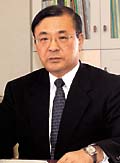
|
At the beginning of the 21st century, research related to broadcasting technology has been experiencing a drastic transformation. After the establishment of the digital broadcasting system, for satellite terrestrial and cable networks, the broadcasting contents being delivered on such systems will increase in importance. There is a potential for new services that will be linked to portable telephones and broadband communications systems. Furthermore, it is estimated that the number of people over 65 years of age will exceed 20% of the total Japanese population by 2010. We are going to put an emphasis on research into human-friendly broadcasting systems, through which the elderly and those with physical disabilities will be able to enjoy broadcasting services in the same way as others. According to a survey that the NHK Broadcasting Culture Research Institute conducted in 1998, the top five responses to viewers "expectations for future television" were:
Digital BS broadcasting, which began in December 2000, satisfies items 4 and 5. Items 1, 2, and 3 reflect a strong desire by viewers to see a correction of the flaws inherent in conventional broadcasting, which provides one-way, non-interactive programs. Satisfying these wishes will require studies with a focus on a 5A broadcasting system: one that can offer Anything, at Anytime, Anywhere, for Anyone, and through Any media. Broadcasting has developed as technologies advance. Technology will continue to advance at an accelerated pace in the future. We are renewing our vow to make the completion of our new research facility the first step toward the realization of our viewer's dreams over the next 10 to 20 years. |
 At the Completion of the New STRL Research Complex
At the Completion of the New STRL Research Complex